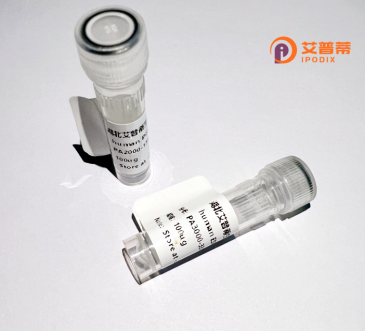
| 纯度 | >90%SDS-PAGE. |
| 种属 | Human |
| 靶点 | CHST5 |
| Uniprot No | Q9GZS9 |
| 内毒素 | < 0.01EU/μg |
| 表达宿主 | E.coli |
| 表达区间 | 1-411aa |
| 氨基酸序列 | MGMRARVPKVAHSTRRPPAARMWLPRFSSKTVTVLLLAQTTCLLLFIISRPGPSSPAGGEDRVHVLVLSSWRSGSSFLGQLFSQHPDVFYLMEPAWHVWTTLSQGSAATLHMAVRDLMRSIFLCDMDVFDAYMPQSRNLSAFFNWATSRALCSPPACSAFPRGTISKQDVCKTLCTRQPFSLAREACRSYSHVVLKEVRFFNLQVLYPLLSDPALNLRIVHLVRDPRAVLRSREAAGPILARDNGIVLGTNGKWVEADPHLRLIREVCRSHVRIAEAATLKPPPFLRGRYRLVRFEDLAREPLAEIRALYAFTGLTLTPQLEAWIHNITHGSGIGKPIEAFHTSSRNARNVSQAWRHALPFTKILRVQEVCAGALQLLGYRPVYSADQQRDLTLDLVLPRGPDHFSWASPD |
| 分子量 | 46.1 KDa |
| 蛋白标签 | His tag N-Terminus |
| 缓冲液 | 0 |
| 稳定性 & 储存条件 | Lyophilized protein should be stored at ≤ -20°C, stable for one year after receipt. Reconstituted protein solution can be stored at 2-8°C for 2-7 days. Aliquots of reconstituted samples are stable at ≤ -20°C for 3 months. |
| 复溶 | Always centrifuge tubes before opening.Do not mix by vortex or pipetting. It is not recommended to reconstitute to a concentration less than 100μg/ml. Dissolve the lyophilized protein in distilled water. Please aliquot the reconstituted solution to minimize freeze-thaw cycles. |
以下是关于重组人碳水化合物硫酸转移酶5(CHST5)的3篇代表性文献及其摘要概括:
1. **文献名称**:*"Structural and functional analysis of recombinant human CHST5 in mucin sulfation"*
**作者**:Saito et al.
**摘要**:研究通过表达重组CHST5蛋白,解析其三维结构,并证实其在肠黏膜黏蛋白糖链的硫酸化修饰中起关键作用,影响黏液的屏障功能。
2. **文献名称**:*"CHST5-mediated sulfation regulates intestinal microbial symbiosis and inflammation"*
**作者**:Kimura et al.
**摘要**:发现CHST5通过催化黏蛋白硫酸化,改变肠道菌群组成,缺失该酶的小鼠易患结肠炎,揭示其维持肠道稳态的机制。
3. **文献名称**:*"Substrate specificity of recombinant human CHST5 in glycosaminoglycan biosynthesis"*
**作者**:Chen et al.
**摘要**:利用重组CHST5酶进行体外实验,验证其对特定糖胺聚糖(如硫酸软骨素)的催化活性,明确了底物结合的关键结构域。
这些文献涵盖了CHST5的结构功能、生理病理作用及酶学特性,可根据实际研究方向进一步拓展检索。
Carbohydrate sulfotransferase 5 (CHST5) is a member of the sulfotransferase family that catalyzes the transfer of sulfate groups to carbohydrate moieties, particularly to chondroitin sulfate and dermatan sulfate proteoglycans. These sulfated glycans play critical roles in cell-cell communication, extracellular matrix organization, and signaling pathways. CHST5 specifically sulfates the C-6 position of N-acetylgalactosamine (GalNAc) residues in chondroitin, influencing proteoglycan function in tissue development, inflammation, and cancer progression. The enzyme is predominantly expressed in mucosal tissues, such as the gastrointestinal tract, where it contributes to maintaining mucosal integrity and host-microbe interactions.
Recombinant human CHST5 (rhCHST5) is produced via heterologous expression systems (e.g., mammalian, insect, or bacterial cells) to study its biochemical properties, substrate specificity, and regulatory mechanisms. Its recombinant form enables high-purity, scalable production for functional studies and therapeutic exploration. Research has linked CHST5 dysregulation to pathologies like colorectal cancer and inflammatory bowel disease, where altered sulfation patterns disrupt cellular adhesion and promote malignancy. Structural analyses of rhCHST5 have revealed insights into its catalytic domain and cofactor (3'-phosphoadenosine 5'-phosphosulfate, PAPS) binding sites, supporting drug discovery efforts targeting sulfation-related disorders. Current applications include exploring its role in designing glycosylation-engineered biologics or inhibitors to modulate proteoglycan-dependent pathways in disease contexts.
×